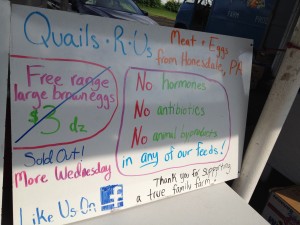My last month in Pennsylvania marked a transition from working on the farm to working with customers at the farmer’s markets. I had been attending markets already once or twice a week, but they were small, and I usually had help. That changed though when the Scranton Co-op Market started in mid-July. This three day a week market runs for nine hours at a time, and has been open since 1939. It’s a very established market and getting in was quite a feat. I was given basically full control of how to manage this market, since I was to be the one working it, a task I did not take lightly. And by the end of that month, I had learned a lot of dealing with customers.
The basic schedule of any farmer’s market is that you arrive a few hours before it opens to the public. You set up your tent and your tables, unload your product, make signs, put out promotional materials, and wait for the sales to start. QRS packs their product in large coolers, so customers don’t get a chance to casually view the inventory we have to sell, unlike a vegetable stand or a craft stand. This is why making the sign is so important. For most of the season, our signs were customized for each market on a white-board with dry erase markers. We used various colors and boldness levels to emphasize certain products over others. I learned how to organize information on a sign very well, as well as where to place the sign to get the attention of passersby. Later in the season, the farm purchased permanent signs that listed all of our inventory, even if we didn’t have every product at that particular market. For this reason, I kept using white-board signs in addition to the permanent signs. Smaller signs are also good for advertising sales or specialty products. When we had barn kittens that needed to be adopted out, we used smaller signs to communicate this to our customers. You can get a lot of information across in few words if you’re practiced enough.

A sample of my signmaking
At any market, you’re going to be asked a lot of questions. Some are out of valid curiosity: What does free range mean? Do brown eggs taste differently, or are they healthier, than white eggs? How do you use chicken feet? What do quail eggs taste like? Some are out of a desire to know the food better: Do you use antibiotics? How much time do your sheep spend outside? How fresh are these eggs? Do you feed your pigs GMO corn? Then you have the strange questions: Do you have live chickens in those coolers? Do you have to cut a chicken to get half a chicken? Do you sell rabbit eggs? And, my personal favorite, are you selling coffins for children? I suppose our white coolers may look a little bit sinister, but no farmer’s market I know of has coffin vendors. A good market worker needs to be able to answer all these questions, to know the business and the philosophy inside and out to satisfy curiosity and make the sale. I genuinely loved engaging with our customers. When people came back saying how excellent our product was, I took it as a personal victory. I enjoyed answering questions, taking orders for the future, showing off the product, and adding up the total, and I enjoyed watching the various people go about their business shopping for their meals. Farmer’s markets are a delight.
One thing I wasn’t expecting was the amount of politics that goes on  behind the scenes. I suppose like any group, the vendors of a market have disputes and tensions. Some are resolved cordially, usually through a market manager or a vote, some not so cordially, and some are never resolved, but just simmer just under the surface, making enjoying the market a very difficult prospect. All vendors are there for the same reason: to make money while helping the consumer eat fresh, local, and sustainable food. It’s a shame that such petty disagreements can destroy the sense of community in a market so easily.
behind the scenes. I suppose like any group, the vendors of a market have disputes and tensions. Some are resolved cordially, usually through a market manager or a vote, some not so cordially, and some are never resolved, but just simmer just under the surface, making enjoying the market a very difficult prospect. All vendors are there for the same reason: to make money while helping the consumer eat fresh, local, and sustainable food. It’s a shame that such petty disagreements can destroy the sense of community in a market so easily.
On the whole, I had a fantastic time working at the markets. It was probably my favorite part of my internship. My market became a part of me, and it was really hard to leave it in the hands of someone else, even if they were my bosses. I met many great people, customers and fellow vendors alike, and I really hope I can work in a farmer’s market again someday in some manner, making people happy and advancing the movement.

